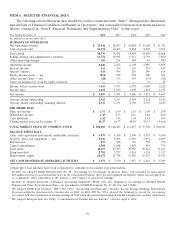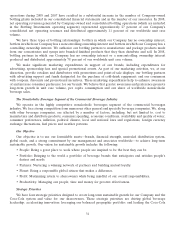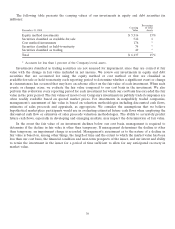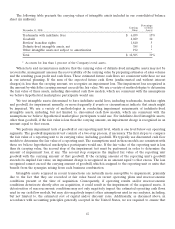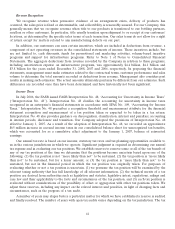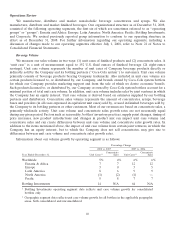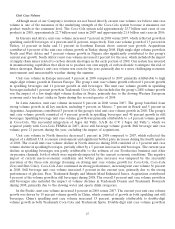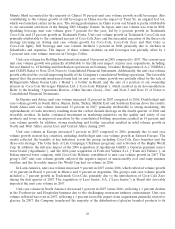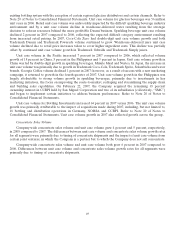Coca Cola 2008 Annual Report Download - page 44
Download and view the complete annual report
Please find page 44 of the 2008 Coca Cola annual report below. You can navigate through the pages in the report by either clicking on the pages listed below, or by using the keyword search tool below to find specific information within the annual report.
The following table presents the carrying values of intangible assets included in our consolidated balance
sheet (in millions):
Percentage
Carrying of Total
December 31, 2008 Value Assets
Trademarks with indefinite lives $ 6,059 15%
Goodwill 4,029 10
Bottlers’ franchise rights 1,840 5
Definite-lived intangible assets, net 385 1
Other intangible assets not subject to amortization 192 *
Total $ 12,505 31%
*Accounts for less than 1 percent of the Company’s total assets.
When facts and circumstances indicate that the carrying value of definite-lived intangible assets may not be
recoverable, management assesses the recoverability of the carrying value by preparing estimates of sales volume
and the resulting gross profit and cash flows. These estimated future cash flows are consistent with those we use
in our internal planning. If the sum of the expected future cash flows (undiscounted and without interest
charges) is less than the carrying amount, we recognize an impairment loss. The impairment loss recognized is
the amount by which the carrying amount exceeds the fair value. We use a variety of methodologies to determine
the fair value of these assets, including discounted cash flow models, which are consistent with the assumptions
we believe hypothetical marketplace participants would use.
We test intangible assets determined to have indefinite useful lives, including trademarks, franchise rights
and goodwill, for impairment annually, or more frequently if events or circumstances indicate that assets might
be impaired. We use a variety of methodologies in conducting impairment assessments of indefinite-lived
intangible assets, including, but not limited to, discounted cash flow models, which are consistent with the
assumptions we believe hypothetical marketplace participants would use. For indefinite-lived intangible assets,
other than goodwill, if the fair value is less than the carrying amount, an impairment charge is recognized in an
amount equal to that excess.
We perform impairment tests of goodwill at our reporting unit level, which is one level below our operating
segments. The goodwill impairment test consists of a two-step process, if necessary. The first step is to compare
the fair value of a reporting unit to its carrying value, including goodwill. We typically use discounted cash flow
models to determine the fair value of a reporting unit. The assumptions used in these models are consistent with
those we believe hypothetical marketplace participants would use. If the fair value of the reporting unit is less
than its carrying value, the second step of the impairment test must be performed in order to determine the
amount of impairment loss, if any. The second step compares the implied fair value of the reporting unit
goodwill with the carrying amount of that goodwill. If the carrying amount of the reporting unit’s goodwill
exceeds its implied fair value, an impairment charge is recognized in an amount equal to that excess. The loss
recognized cannot exceed the carrying amount of goodwill, which is assigned to the reporting unit or units that
benefit from the synergies arising from each business combination.
Intangible assets acquired in recent transactions are naturally more susceptible to impairment, primarily
due to the fact that they are recorded at fair value based on recent operating plans and macroeconomic
conditions present at the time of acquisition. Consequently, if operating results and/or macroeconomic
conditions deteriorate shortly after an acquisition, it could result in the impairment of the acquired assets. A
deterioration of macroeconomic conditions may not only negatively impact the estimated operating cash flows
used in our cash flow models, but may also negatively impact other assumptions used in our analyses, including,
but not limited to, the estimated cost of capital and/or discount rates. Additionally, as discussed above, in
accordance with accounting principles generally accepted in the United States, we are required to ensure that
42


